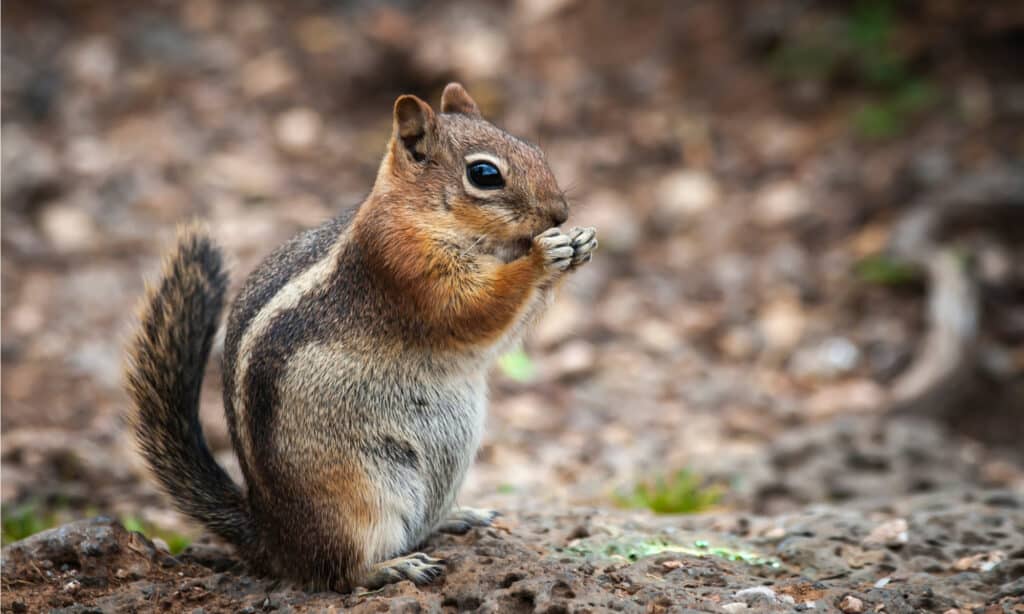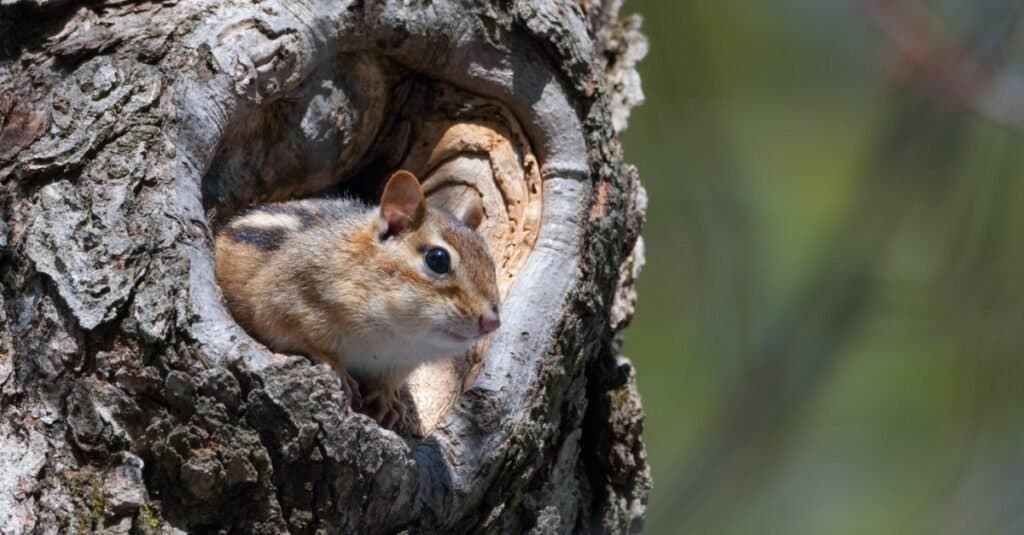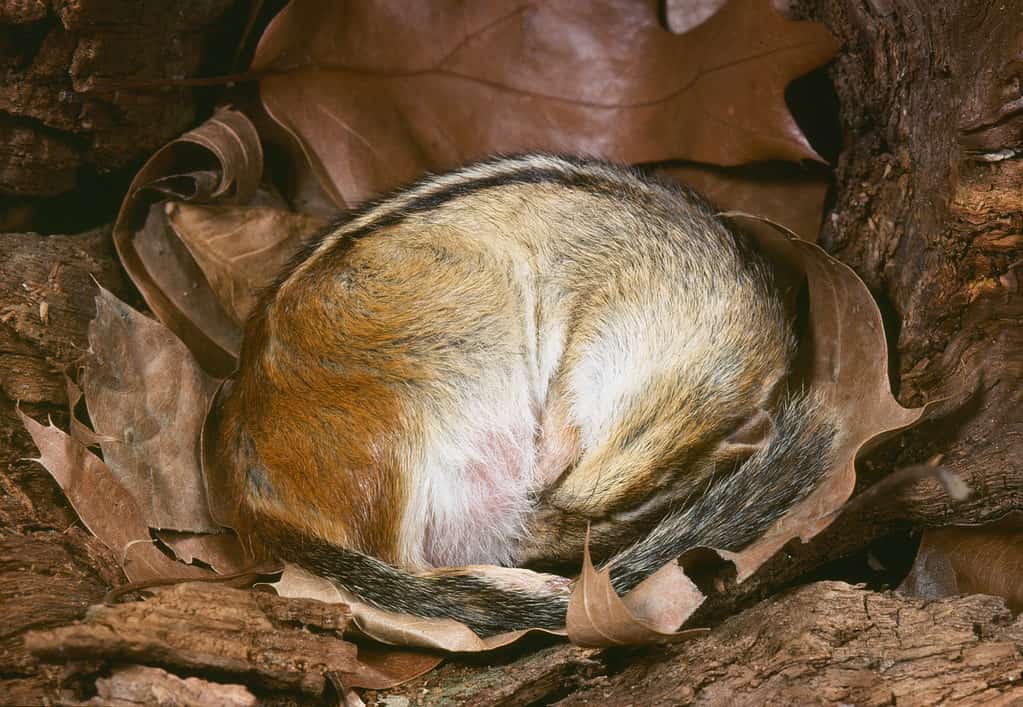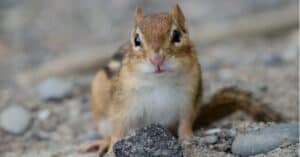Chipmunks are small rodents which are sometimes mistaken for squirrels. They are widespread across North America and are sometimes described as being pests due to their burrowing behavior. However, as chipmunks are part of the squirrel family you might ask yourself, “can chipmunks climb trees?” In this article we’ll discover the answer and explore the reasons behind it. We’ll also learn what chipmunks eat, where they live, and how often they reproduce.
All About Chipmunks

Chipmunks are small, striped rodents in the squirrel family.
©Cindy Larson/Shutterstock.com
Chipmunks are small rodents in the Sciuridae family which is known as the squirrel family. There are 25 species of chipmunks and all but one occur in North America. The exception is the Siberian chipmunk which lives in Asia.
Despite being members of the squirrel family, chipmunks are not exactly the same. Like squirrels, chipmunks have a bushy tail, but it tends to be shorter than that of a squirrel. Chipmunks are also distinguished by their striped appearance. Their stripes are typically on both their faces and backs, although the colors can vary between species. Most chipmunks are between eight and 10 inches long, while the largest is the eastern chipmunk at approximately 12 inches.
As they are rodents, chipmunks have prominent incisor teeth which grow constantly throughout their lifetime. This means that they need to continually chew on hard material so that they can wear them down. If they don’t then they risk them becoming too long for their mouths. Therefore, chipmunks eat a wide variety of seeds, fruit, nuts, and berries. However, they are omnivores and also eat insects, worms, snails, frogs, and even some newly hatched birds.
As winter approaches, chipmunks begin to hoard food and store it in underground caches in their burrows. Although it’s easy to assume that chipmunks hibernate, they actually enter into a state known as torpor. This isn’t true hibernation and is instead a period of decreased activity where they sleep for a few days at a time and then wake up to eat.
Are Chipmunks Capable of Climbing Trees?

Chipmunks climb trees to find food and to escape predators.
©iStock.com/Kyle Bedell
Yes, chipmunks can climb trees! However, just because they can climb trees it doesn’t mean that they do it all the time.
Chipmunks live in deciduous forests, woodland edges, and meadows but are predominantly ground-dwelling animals as they are able to get the majority of their food by foraging on the floor. However, they do still climb sometimes, such as to reach the tasty acorns or nuts that are just a little too high for them to reach from the ground.
The other reason that they will climb trees is to escape from predators. As chipmunks are so small they have many predators and are particularly vulnerable when they are out in the open. Their predators include foxes, coyotes, raccoons, bobcats, birds of prey, and even snakes. Chipmunks naturally prefer to seek shelter in their burrows, but if the need arises they can clamber up a tree to escape from a ground predator. Plus, even climbing a little way up a tree means that the branches can provide overhead cover from aerial predators.
However, chipmunks don’t usually climb very high at all as they are simply unsuited to an arboreal lifestyle. Compared to some other rodents — including squirrels — chipmunks have delicate claws. Simply put, their claws are not robust enough to provide them with the grip needed to regularly climb trees. Furthermore, their legs and bodies are not adapted to leaping between branches. In fact, they can sometimes fall an injure themselves while trying.
Where Do Chipmunks Live?

Chipmunks live in underground burrows which can be up to 30 feet long.
©Breck P. Kent/Shutterstock.com
As we’ve already mentioned, chipmunks live in burrows, and this means that they don’t need to nest in the trees. Instead, their burrows are a vast network of tunnels which can be up to 30 feet long and are typically located two to three feet underground. The entrance consists of a small hole in the ground that is only a few inches wide. Chipmunks often remove the fresh soil from the entrance so that predators are less likely to notice it.
The main chamber in the burrow is the nesting chamber where they sleep. However, there are a number of smaller chambers off it which are used to store food for the winter. They even create a separate chamber as a toilet so they don’t need to go outside during the winter!
Chipmunks are solitary animals and live alone in their burrows, with the only exception being a female and her young. Chipmunks only interact during breeding season. Some species have only one litter per year, with the young being born in the spring following gestation period of four to five weeks, but others will have a second litter in the early summer. Each litter consists of between two and eight infants which are born blind and hairless. They remain with their mother until they are six to eight weeks old and are capable of foraging for themselves. At this point they leave their mother and go off on their own. However, they don’t reach sexual maturity until they are approximately one year old.
The photo featured at the top of this post is © AmberLouise/Shutterstock.com
Thank you for reading! Have some feedback for us? Contact the AZ Animals editorial team.






